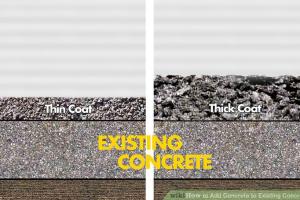Expert Guide: How to Add Concrete to Existing Concrete Like a Pro

-
Quick Links:
- Understanding Concrete and Its Types
- Why Add Concrete to Existing Concrete?
- Preparation: Assessing Your Existing Concrete
- Choosing the Right Concrete Mix
- Step-by-Step Guide to Adding Concrete
- Finishing Techniques for a Polished Look
- Common Mistakes to Avoid
- Maintaining Your New Concrete Surface
- Case Studies: Success Stories
- FAQs
Understanding Concrete and Its Types
Concrete is one of the most versatile and widely used construction materials in the world. It consists of a mixture of cement, water, aggregates (sand, gravel, or crushed stone), and sometimes admixtures to enhance its properties. There are various types of concrete, including:
- Normal Strength Concrete: Basic concrete used for various applications.
- High-Strength Concrete: Used in structures that require high load-bearing capacity.
- Lightweight Concrete: Contains lightweight aggregates for reduced weight.
- Reinforced Concrete: Contains steel bars or mesh to improve tensile strength.
Understanding the type of concrete in your existing surface is crucial for successful integration.
Why Add Concrete to Existing Concrete?
Adding concrete to an existing surface can serve multiple purposes:
- Resurfacing: Improving the appearance of worn-out concrete.
- Repairs: Fixing cracks and damages.
- Expansion: Increasing the surface area for new constructions like patios or walkways.
- Leveling: Correcting uneven surfaces.
Each of these purposes requires specific techniques and materials for optimal results.
Preparation: Assessing Your Existing Concrete
Before you add new concrete, it is essential to assess the condition of the existing surface:
- Check for cracks, spalling, or other damage.
- Determine the surface's moisture content.
- Clean the surface to remove dirt, grease, and debris.
Conducting a thorough assessment will help you decide whether you need to repair the existing concrete before adding new layers.
Choosing the Right Concrete Mix
When selecting a concrete mix, consider the following factors:
- Purpose: Is it for repair, resurfacing, or expansion?
- Environment: Will it be exposed to water, extreme temperatures, or chemicals?
- Thickness: How thick will the new layer be?
Consult with suppliers or industry experts to find the best mix for your needs. For instance, a Cement Association can provide insights into suitable products.
Step-by-Step Guide to Adding Concrete
1. Gather Materials and Tools
You'll need:
- Concrete mix
- Concrete bonding agent
- Mixing tools
- Finishing tools (trowels, floats)
- Safety gear (gloves, goggles)
2. Prepare the Surface
As mentioned, clean the surface thoroughly. If there are cracks, use a chisel to widen them and then fill them with a suitable repair mix.
3. Apply Bonding Agent
After cleaning, apply a concrete bonding agent to ensure a strong bond between the old and new concrete.
4. Mix and Pour the Concrete
Follow the manufacturer's instructions for mixing. Pour the concrete onto the prepared surface and use a trowel to spread it evenly.
5. Finishing Touches
Use a float to smooth the surface. For decorative finishes, consider adding textures or colors at this stage.
Finishing Techniques for a Polished Look
Finishing your concrete can enhance its appearance and durability. Here are some techniques:
- Brushing: For a non-slip surface.
- Staining: To add color and character.
- Sealing: To protect against moisture and stains.
Common Mistakes to Avoid
Here are some pitfalls to steer clear of:
- Not cleaning the surface properly.
- Ignoring weather conditions during application.
- Using the wrong concrete mix.
Maintaining Your New Concrete Surface
To prolong the life of your newly added concrete, follow these maintenance tips:
- Seal the concrete every few years.
- Keep it clean and free of debris.
- Avoid harsh chemicals that can damage the surface.
Case Studies: Success Stories
Consider the following examples of successful concrete additions:
- Residential Project: A homeowner added a concrete patio over an existing slab, enhancing outdoor living space.
- Commercial Project: A store renovated its entrance by overlaying concrete, improving aesthetics and accessibility.
FAQs
1. Can I add concrete to existing concrete without a bonding agent?
While it’s possible, using a bonding agent significantly improves adhesion and durability.
2. How thick can I add concrete over existing concrete?
A thickness of 1 to 2 inches is ideal, depending on the purpose and type of mix used.
3. How long does it take for new concrete to cure?
Typically, concrete takes about 28 days to fully cure, but it can be used lightly after 24-48 hours.
4. Can I add concrete in cold weather?
Yes, but special precautions are necessary to prevent freezing.
5. What are the signs that my existing concrete needs repair?
Cracks, spalling, and uneven surfaces are indicators that repair is necessary before adding new concrete.
6. Is professional help necessary for adding concrete?
While DIY is possible, professionals can ensure a better finish and structural integrity.
7. How do I know which concrete mix to use?
Consult with suppliers or refer to the project requirements for guidance on the suitable mix.
8. Can I use leftover concrete for small patches?
Yes, as long as it’s still workable and hasn’t begun to set.
9. What is the best time of year to add concrete?
Spring and fall are ideal as temperatures are moderate; avoid extreme hot or cold.
10. How can I enhance the appearance of my new concrete?
Consider staining, stamping, or adding decorative finishes for a unique look.
Random Reads
- Ultimate guide fusing messiah persona 3
- Save youtube subtitles
- Scan documents to pdf
- How to wipe a computer
- How to wipe a mac clean
- Simple ways remove flash drive windows 10
- Why is screen time not working
- Why your phone disconnects from wifi
- Mastering your bissell proheat pet
- Mastering word grouping objects